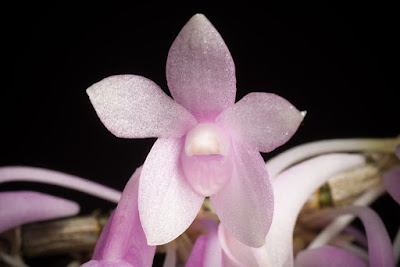Dendrobium lawesii is native to Bougainville Island and North Papua New Guinea. These orchids grow on the undersides of the branches of rainforest trees or on the lower branches, in large shade.
Dendrobium lawesii also called as Lawes' Dendrobium (named to honor An English Missionary and Collector), Chromatotriccum delphinioides, Chromatotriccum lawesii, Dendrobium delphinioides, Dendrobium lawesii var. salmonicolor, Dendrobium psuedomohlianum, Dendrobium warburgianum, Pedilonum lawesii, is a species of the genus Dendrobium. This species was described by Ferdinand von Mueller in 1884.
IDENTIFY DENDROBIUM LAWESII
Dendrobium lawesii is native to Bougainville Island and North Papua New Guinea. These orchids grow on the undersides of the branches of rainforest trees or on the lower branches, in large shade. In New Guinea, they are found in the areas of Finisterre, Ibo and Bismarck, at an altitude of 800-1500m. On the island of Bougainville they occur at heights of 900-2000 m.
It is a medium sized, warm to cool growing epiphyte, which reaching 25-45 cm in height, with thin, flattened, 25-45 cm long stems carrying broadly ovate, acute or obtuse, bilaterally flattened, distichous, 6.5 cm long, thick and fleshy leaves that overlap at the base.
Lawes' Dendrobium has a very short (less than 2", or 5 cm) raceme that arises from the old and new leafless canes with from 1 to 6, pendant, showy , highly variable flowers that occur at most any time of the year. The flowers are 1.5 cm in diameter and 2.5 cm in length. They are effective, bell-shaped and very changeable. The petals of both whorls usually have a bright, bright color and sometimes whitened tops. They can be red, orange, purple, purple, salmon, yellow or white, there are also two-colored forms. The upside-down lip is often off-white.
DENDROBIUM LAWESII CARE AND CULTURE
Cultural information should only be used as a guide, and should be to be adapted to suit you. Your physical location; where you grow your plants, how much time you have to devote to their care, and many other factors, will need to be taken into account. Only then can you decide on the cultural methods that best suit you and your plants.
Light:
Dendrobium lawesii needs a light level of 12000-25000 lux. This orchid fits the same lighting as for Phalaenopsis.
Temperature:
The average day temperature during the whole year is 27-28 ° C, night 15-18 ° C, giving a daily difference of 10-12 ° C.
Humidity:
From summer to autumn, Lawes' Dendrobium needs the average humidity of 70-75% and it drops to 65-70% in winter and spring. These plants require a strong air movement.
Substrate, growing media and repotting:
Hanging pots or baskets are best suited to the hanging habit of these plants and very good air movement is needed, which is especially important. Dendrobium lawesii require any loose, quickly drying substrate. Although these plants have a hanging habit, it is almost impossible to grow these plants mounted on rootstocks, unless this installation was done when the plants were very small. Repotting can be done at any time when new roots are growing.
Watering:
In nature, most of the year the precipitation is moderate to abundant, but during the three winter months it is drier. In culture, the substrate must be permanently moist, but not wet. It is very useful to periodically spray the plant in the mornings, especially in clear weather.
Fertilizer:
It is recommended to weekly or every two weeks use 1/4-1/2 dose of fertilizer for orchids. It is beneficial to use a balanced fertilizer throughout the year.
Rest period:
A slightly more dry resting period is necessary to induce flowering, and reducing the amount of water and fertilizer after reaching maturity through shoots helps flowering. The amount of water and fertilizers should be slightly reduced, especially Dendrobium lawesii grown in the conditions of a dark, short day at moderate latitudes. The plants should be dried, but it should not be allowed to stay dry for too long. Fertilization should be reduced or eliminated until spring, when more watering resumes.















COMMENTS